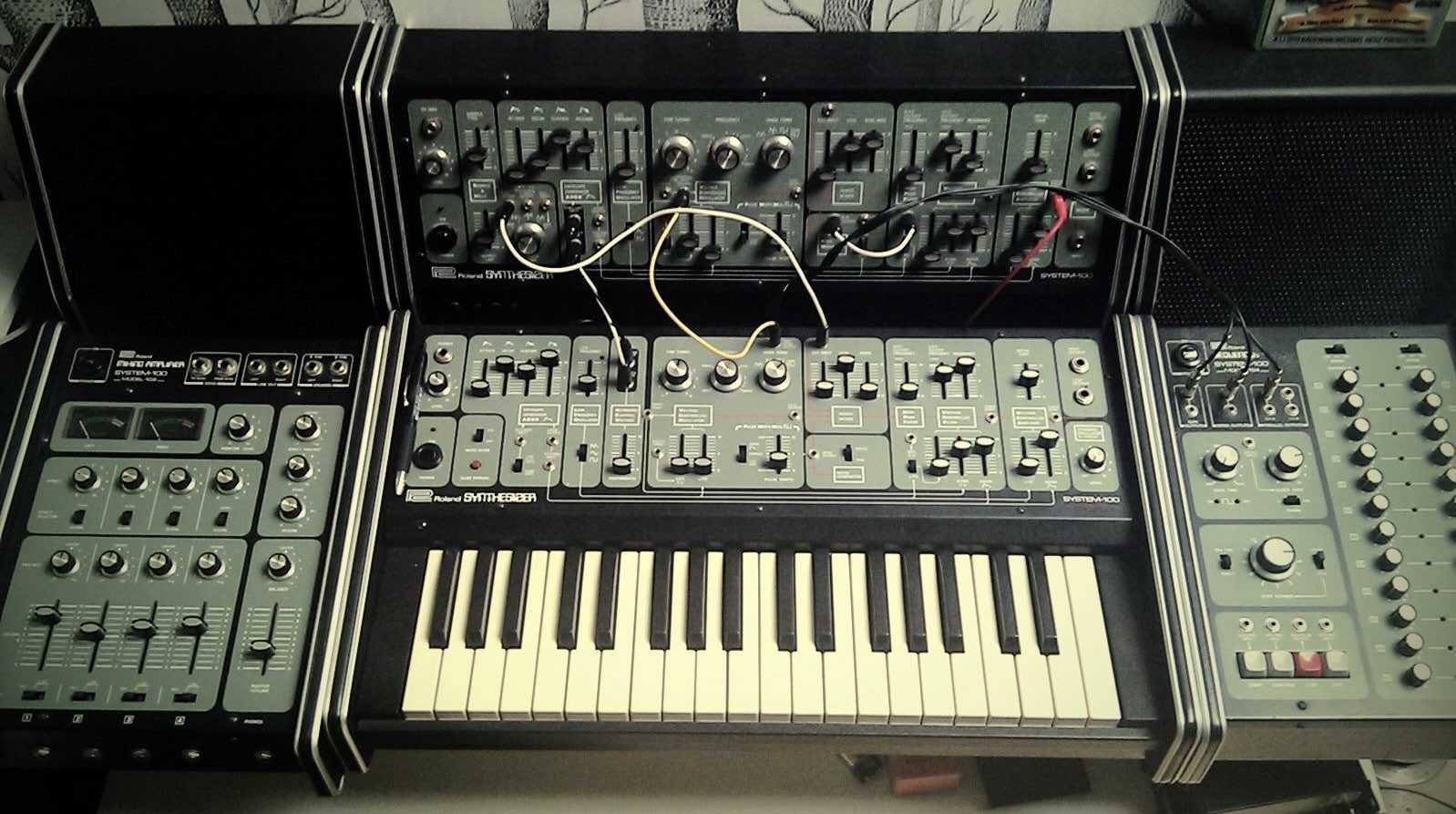
The System 100 is a great and classic analog synth! It’s a beautiful semi-modular monophonic synth consisting of 5 module components: the Synthesizer 101, Expander 102, Mixer 103, Sequencer 104, and Monitor Speakers 109. The Synthesizer 101 section is the heart of the system, from which you could add-on any of the other modules of your choice. Different combinations of these components can be used to create systems of varying potential.
The Synthesizer 101 section is a fully self-contained analog mono-synth. It features a 37-note keyboard (with no performance controls, velocity or aftertouch), and lots of sliders to tweak. Its design is similar to the SH-series analog synths. Controls for the VCO, LFO, VCF lowpass/highpass filters, VCA with ADSR, Noise, and Portamento/Glide effects are all within hands reach. There’s also a handy A-440Hz tuning oscillator, like on the Minimoog.
The Mixer 103 is a cool add-on. Features 4 inputs and 4 sliders, and mixes these down to 2 outputs. There are two analog VU meters (a nice touch) as well as panning, mono effect sends/returns, and a built-in spring reverb! The Model 103 is designed to sit on the right side of the System and feeds the Monitor Speakers. The speakers provide a stereo monitoring source which is another great (optional) touch! The Mixer not only has outputs for these speakers, but also Line-Outs for use live or in the studio! On the left side of the System sits the Sequencer 104. This analog sequencer can be used to drive your System with a 12×2 step pattern sequencer. It features variable gate time, series or parallel modes, Start, Stop, Continue, and Step buttons.
The System 100 is a great sounding analog system with the classic vintage Roland sound. Although it is itself an impressive system, Roland took the concept a step further developing additional modules for the System 100m. Although the 100m has greater patching freedom, it doesn’t sound as warm as the 100. Apparently the 100 has the same filter chip as a TB-303, but it certainly doesn’t produce the same sound, the System 100 sounds better! Whatever configuration you find a System 100 in, they are all powerful, warm, and useable machines!
| Modules | Description |
|---|---|
| 110 | VCO single oscillator (with VCA and VCF sections) |
| 111 | VCO/VCF (unreleased prototype) |
| 112 | dual VCO, with 3 CV ins, 2 outs, and weak/strong sync |
| 120 | VCA (unreleased prototype) |
| 121 | dual VCF, with low-pass and high-pass filters with 24 dB/oct slope |
| 130 | dual VCA, with a linear/exponential switch |
| 131 | Mixer, 4 X 2 X 1, with panning and a tuning oscillator (220/440/880Hz) |
| 132 | dual Mixer and Voltage Processor |
| 140 | dual Envelope (ADSR, invertable, and manual gate button) and LFO (5 waveforms with switchable range: x1, x1/10) |
| 141 | dual Envelope, Gate Delay, and Invert/Adder |
| 150 | Ring Mod, Noise (pink and white), S&H (with lag), and LFO (5 waveforms with switchable range: x1, x1/10) |
| 160 | Computer Interface |
| 165 | Double Portamento Controller, with CV in |
| 170 | Pitch/Voltage Converter, Envelope Follower, and Audio Amp |
| 172 | Phase Shifter, Audio Delay, LFO, Gate Delay |
| 173 | Quadruple Signal Gate and six 4-way Multiples |
| 174 | Parametric Equalizer, four-band, with 20Hz to 20kHz center frequencies |
| 180 | Keyboard, 32-note (F-C) low note priority, with transpose switch and portamento knob |
| 181 | Keyboard, 49-note (C-C) same as 180 but with added portamento switch and bender lever (with CV out) |
| 182 | Analog Sequencer, 2 X 8 step, serial or parallel modes |
| 184 | Keyboard, 49-note (C-C) 4-voice, with switchable mono/polyphonic, an arpeggiator, and polyphonic portamento |
| 190 | three-module rack with connection sockets at the base |
| 190B | base unit that elevates the 190 above a keyboard |
| 191 | five-module rack |
| 191J | five-module rack with multiple connectors on its base |
It is used by Orbital, Vince Clarke, Aphex Twin, BBC Radiophonic Workshop, Electronic Dream Planet, Tangerine Dream, Groove Corporation, Depeche Mode, Heaven 17, Freddy Fresh, Joy Electric, Luke Vibert, Human League, Nitzer Ebb, Front 242, Tears For Fears, Vangelis, Hans Zimmer, and Meat Beat Manifesto.



